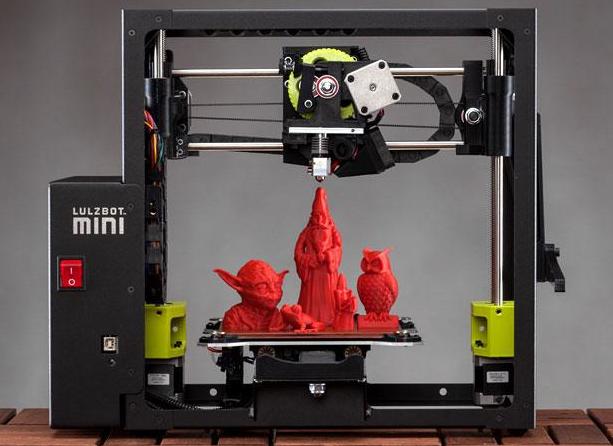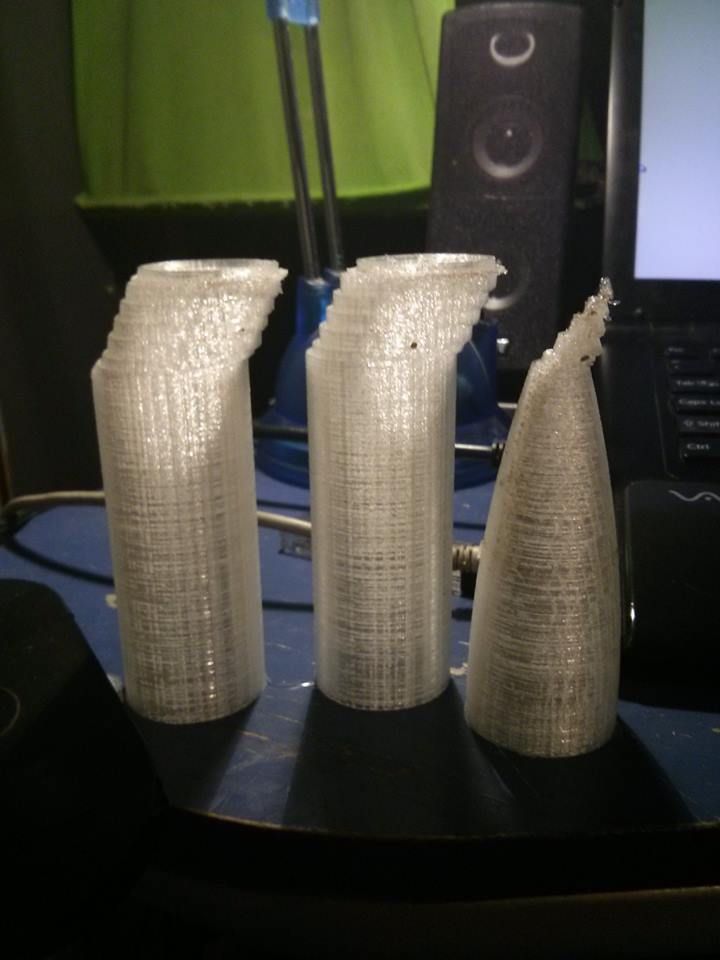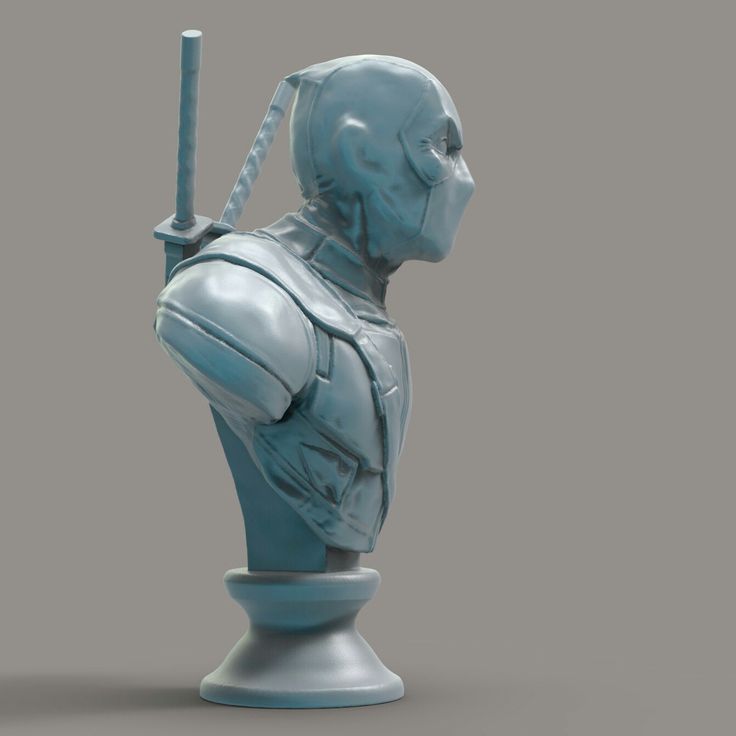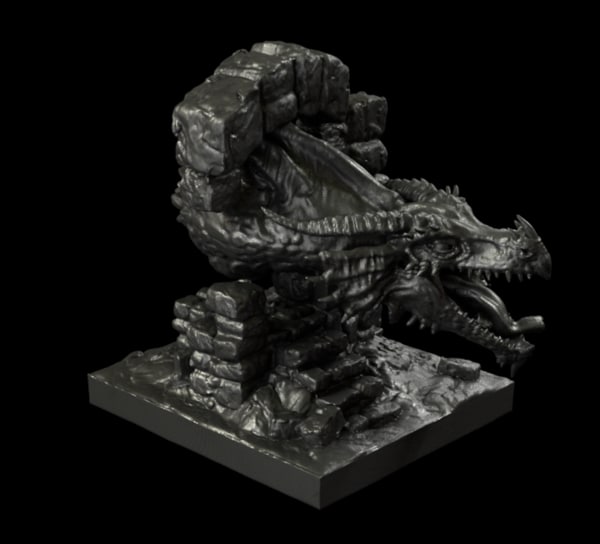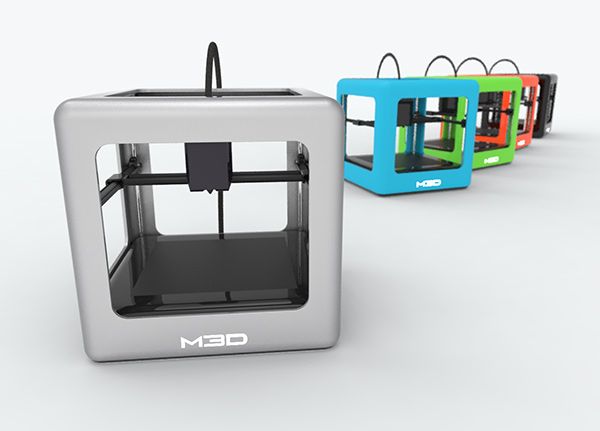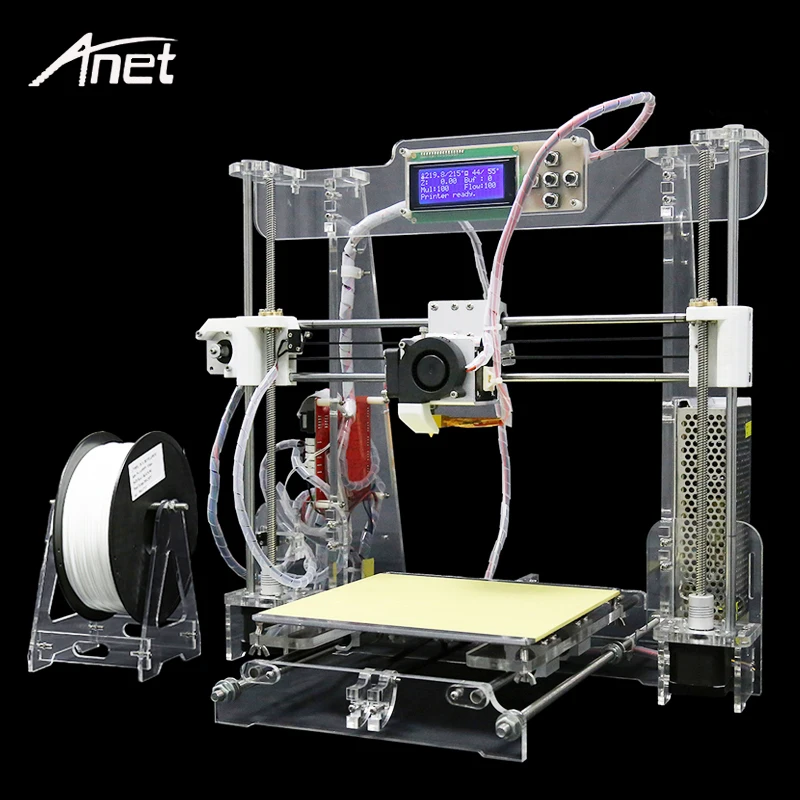Perform 3d printing
PerFORM for Stereolithography | Materialise
Material
A resin with ceramic particles, PerFORM produces strong, stiff parts with high thermal resistance. It is ideal for functional prototypes for demanding applications such as wind tunnel tests and high-heat tests in the aerospace and automotive industries. PerFORM's superior sidewall quality and excellent detail resolution also make it a good choice for rapid tooling for injection molding.
Technical specifications
| Maximum part dimensions | 500 x 500 x 568 mm |
| Standard accuracy | ±0.2% (with a lower limit of ±0.2 mm) |
| Layer thickness | 0.1 mm |
| Minimum wall thickness | 1 – 3 mm depending on part dimensions |
| Minimum detail size | 0.5 mm |
| Interlocking or moving parts | No |
| Internal channels | Yes, but support structures may remain inside channels |
| Surface structure | Smooth surface with visible building layers; off-white material |
Datasheet
| PARAMETER | VALUE | UNIT | METHOD |
Density ASTM D792 | 1. | g/cm³ | ASTM D792 |
Tensile strength ASTM D638 | 68 | MPa | ASTM D638 |
Tensile modulus ASTM D638 | 10.500 | MPa | ASTM D638 |
Flexural strength ASTM D790 | 120 | MPa | ASTM D790 |
Flexural modulus ASTM D790 | 10.000 | MPa | ASTM D790 |
Impact strength ASTM D256 (Notched, Izod) | 17 | J/m | ASTM D256 (Notched, Izod) |
Elongation at break ASTM D638 | 1.1 | % | ASTM D638 |
Hardness ASTM D2240 | 94 | Shore D | ASTM D2240 |
Heat deflection temperature ASTM D648 (@1.82 MPa) | 82 | °C | ASTM D648 (@1.82 MPa) |
Glass transition temperature ASTM E1545 | 72 | °C | ASTM E1545 |
Actual values may vary with build conditions.
Download as PDF
Finishing degrees
The right finish can transform your print into a product. Explore the post-production finishes we offer for this material. If you have any questions or special requests, get in touch with us.
Support marks removed
Normal
Primer + paint A-side/2-side (dead matte, 10% gloss)
Primer + paint A-side/2-side (matte, 30% gloss)
Primer + paint A-side/2-side (satin, 50% gloss)
Primer + paint A-side/2-side (high gloss, 90% gloss)
Primer + paint A-side/2-side (soft touch)
Primer + paint A-side/2-side (fine texture)
Primer + paint A-side/2-side (spatter)
Additional finishes
Get in touch
Would you like to ask a question or start working on a project? We’d love to hear from you.
Talk to our team
Train and learn
Get more from your next project with helpful resources dedicated to PerFORM and stereolithography.
Quick links
Learn more about stereolithographyHow to design for PerFORMVIDEO
Discover Stereolithography
EXPERT INSIGHT
30 Years of Innovation: How Stereolithography Sparked Materialise’s Inventive Ethos
5 min read
VIDEO
Discover Stereolithography
EXPERT INSIGHT
30 Years of Innovation: How Stereolithography Sparked Materialise’s Inventive Ethos
5 min read
© Copyright Materialise 2022
Cookie Statement
Legal terms
Privacy notice
Stereolithography (SLA) 3D Printing Service
Back
-
Materials
Materials by Service
Injection MoldingCNC Machining3D PrintingSheet Metal
Materials by Type
PlasticsMetalsElastomers
Related Links
Customer Supplied ResinsColors
Injection Molding Material Alternatives Guide
Struggling with thermoplastic material shortages? We created a detailed guide to resin substitutes for ABS, PC, PP, and other commonly molded thermoplastics.

Download
-
Resources
Design Tips Guides and Trend Reports Success Stories Design Aids Webinars & Trade Shows
Blog Videos FAQs Educators & Students Glossary
Industries Medical Aerospace Automotive Consumer Electronics Industrial Equipment
-
About Us
Who We Are Why Protolabs? Research and Development Cool Idea Award Partnerships Sustainability & Social Impact
Careers Investors Locations Press Procurement
Contact Us
Proto Labs, Inc.
5540 Pioneer Creek Dr.
Maple Plain, MN 55359
United StatesP: 877.479.3680
F: 763.479.2679
E: [email protected]Best-in-Class Online Quoting
After uploading your part design, you'll receive an online quote that includes manufacturing analysis to help improve part manufacturability. Within your quote, you can also adjust quantity and material and see price changes in real-time.

Learn More
Get a QuoteSign In
SLA 3D printing service for rapid prototyping. Get an instant online quote.
GET SLA PARTS
Jump to Section→ Capabilities
→ SLA Materials
→ Compare SLA Material Properties
→ Surface Finishes
→ Post-Processing
→ Our SLA 3D Printers
→ Why SLA 3D Printing?
Stereolithography (SLA) is an industrial 3D printing process used to create concept models, cosmetic prototypes, and complex parts with intricate geometries in as fast as 1 day. A wide selection of materials, extremely high feature resolutions, and quality surface finishes are possible with SLA.
SLA 3D printing is primarily used for:
- parts requiring high accuracy and features as small as 0.002 in.
- good surface quality for cosmetic prototypes
- form and fit testing
If you have any issues getting your guide, click here to download.
3D Printing Surface Finish Guide
Get this quick reference guide to explore your surface finish options across our six 3D printing technologies.
United States of AmericaAfghanistanÅland IslandsAlbaniaAlgeriaAmerican SamoaAndorraAngolaAnguillaAntarcticaAntigua and BarbudaArgentinaArmeniaArubaAustraliaAustriaAzerbaijanBahamasBahrainBangladeshBarbadosBelarusBelgiumBelizeBeninBermudaBhutanBolivia, Plurinational State ofBonaire, Sint Eustatius and SabaBosnia and HerzegovinaBotswanaBouvet IslandBrazilBritish Indian Ocean TerritoryBrunei DarussalamBulgariaBurkina FasoBurundiCambodiaCameroonCanadaCape VerdeCayman IslandsCentral African RepublicChadChileChinaChristmas IslandCocos (Keeling) IslandsColombiaComorosCongoCongo, the Democratic Republic of theCook IslandsCosta RicaCôte d'IvoireCroatiaCubaCuraçaoCyprusCzech RepublicDenmarkDjiboutiDominicaDominican RepublicEcuadorEgyptEl SalvadorEquatorial GuineaEritreaEstoniaEthiopiaFalkland Islands (Malvinas)Faroe IslandsFijiFinlandFranceFrench GuianaFrench PolynesiaFrench Southern TerritoriesGabonGambiaGeorgiaGermanyGhanaGibraltarGreeceGreenlandGrenadaGuadeloupeGuamGuatemalaGuernseyGuineaGuinea-BissauGuyanaHaitiHeard Island and McDonald IslandsHoly See (Vatican City State)HondurasHong KongHungaryIcelandIndiaIndonesiaIran, Islamic Republic ofIraqIrelandIsle of ManIsraelItalyJamaicaJapanJerseyJordanKazakhstanKenyaKiribatiKorea, Democratic People's Republic ofKorea, Republic ofKuwaitKyrgyzstanLao People's Democratic RepublicLatviaLebanonLesothoLiberiaLibyaLiechtensteinLithuaniaLuxembourgMacaoMacedonia, the Former Yugoslav Republic ofMadagascarMalawiMalaysiaMaldivesMaliMaltaMarshall IslandsMartiniqueMauritaniaMauritiusMayotteMexicoMicronesia, Federated States ofMoldova, Republic ofMonacoMongoliaMontenegroMontserratMoroccoMozambiqueMyanmarNamibiaNauruNepalNetherlandsNew CaledoniaNew ZealandNicaraguaNigerNigeriaNiueNorfolk IslandNorthern Mariana IslandsNorwayOmanPakistanPalauPalestine, State ofPanamaPapua New GuineaParaguayPeruPhilippinesPitcairnPolandPortugalPuerto RicoQatarRéunionRomaniaRussian FederationRwandaSaint BarthélemySaint Helena, Ascension and Tristan da CunhaSaint Kitts and NevisSaint LuciaSaint Martin (French part)Saint Pierre and MiquelonSaint Vincent and the GrenadinesSamoaSan MarinoSao Tome and PrincipeSaudi ArabiaSenegalSerbiaSeychellesSierra LeoneSingaporeSint Maarten (Dutch part)SlovakiaSloveniaSolomon IslandsSomaliaSouth AfricaSouth Georgia and the South Sandwich IslandsSouth SudanSpainSri LankaSudanSuriNameSvalbard and Jan MayenSwazilandSwedenSwitzerlandSyrian Arab RepublicTaiwan, Province of ChinaTajikistanTanzania, United Republic ofThailandTimor-LesteTogoTokelauTongaTrinidad and TobagoTunisiaTurkeyTurkmenistanTurks and Caicos IslandsTuvaluUgandaUkraineUnited Arab EmiratesUnited KingdomUnited States Minor Outlying IslandsUruguayUzbekistanVanuatuVenezuela, Bolivarian Republic ofViet NamVirgin Islands, BritishVirgin Islands, U.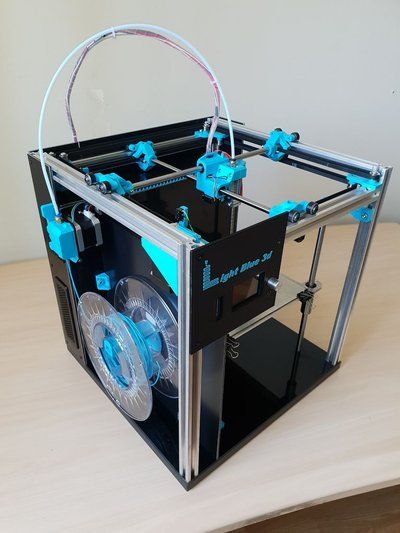 S.Wallis and FutunaWestern SaharaYemenZambiaZimbabwe
S.Wallis and FutunaWestern SaharaYemenZambiaZimbabwe
I agree to receive email messages containing service updates and Design Tips from Protolabs and its affiliates
SLA Design Guidelines and Capabilities
Our basic guidelines for stereolithography include important design considerations to help improve part manufacturability, enhance cosmetic appearance, and reduce overall production time.
SLA Tolerances
For well-designed parts, tolerances in the X/Y dimension of ±0.002 in. (0.05mm) for first inch plus 0.1% of nominal length. (0.001mm/mm), and Z dimension tolerances of ±0.005 in. for first inch plus 0.1% of nominal length, can typically be achieved. Note that tolerances may change depending on part geometry.
Max Part Size
Layer Thickness
Minimum Feature Size
Minimum Wall Thickness
Minimum Hole Size
Tolerances
*Available for the following materials: ABS-Like White and Gray, ABS-Like Translucent/Clear, and PC-Like Translucent/Clear
SLA Material Options
ABS-Like White (Accura Xtreme White 200)
ABS-Like White (Accura Xtreme White 200) is a widely used general purpose SLA material. In terms of flexibility and strength, this material falls between molded polypropylene and molded ABS, which makes it a good choice for functional prototypes. Parts as large as 29 in. x 25 in. x 21 in. can be built with ABS-Like White so consider it a primary option if you require an extensive part size build envelope.
In terms of flexibility and strength, this material falls between molded polypropylene and molded ABS, which makes it a good choice for functional prototypes. Parts as large as 29 in. x 25 in. x 21 in. can be built with ABS-Like White so consider it a primary option if you require an extensive part size build envelope.
Primary Benefits
- Durable, general purpose resin
- Accommodates extra-large parts
ABS-Like Gray (Accura Xtreme Gray)
ABS-Like Gray (Accura Xtreme Gray) is a widely used general purpose SLA material. In terms of flexibility and strength, this material falls between molded polypropylene and molded ABS, which makes it a good choice for functional prototypes. ABS-Like Gray offers the highest HDT of the ABS-like SLA resins.
Primary Benefits
- Durable, general purpose resin
- Highest HDT of the ABS-like SLA resins
ABS-Like Black (Accura 7820)
ABS-Like Black (Accura 7820) is a widely used general purpose material. Its deep black color and glossy up-facing surfaces in a top profile offer the appearance of a molded part, while layer lines may be visible in a side profile. RenShape 7820 also has low moisture absorption (0.25% per ASTM D570) so that parts are more dimensionally stable. Compared to other SLA materials, it has midrange values for all mechanical properties.
Its deep black color and glossy up-facing surfaces in a top profile offer the appearance of a molded part, while layer lines may be visible in a side profile. RenShape 7820 also has low moisture absorption (0.25% per ASTM D570) so that parts are more dimensionally stable. Compared to other SLA materials, it has midrange values for all mechanical properties.
Primary Benefits
- Low moisture absorption
- Glossy cosmetic appearance
ABS-Like Translucent/Clear (WaterShed XC 11122)
ABS-Like Translucent/Clear (WaterShed XC 11122) offers a unique combination of low moisture absorption (0.35% 0.25% per ASTM D570) and near-colorless transparency. Secondary operations are required to achieve functional part clarity, and the part will also retain a very light blue hue afterward. While good for general-purpose applications, WaterShed is the best choice for flow-visualization models, light pipes, and lenses.
Primary Benefits
- Lowest moisture absorption of SLA resins
- Functional transparency
MicroFine™ (Gray and Green)
MicroFine™ is a custom formulated material available in gray and green that is exclusive to Protolabs. This ABS-like thermoset is printed in Protolabs’ customized machinery to achieve high resolution features as small as 0.002 in. MicroFine is ideal for small parts, generally less than 1 in. by 1 in. by 1 in. In terms of mechanical properties, MicroFine falls in the mid-range of SLA materials for tensile strength and modulus and on the low end for impact strength and elongation.
This ABS-like thermoset is printed in Protolabs’ customized machinery to achieve high resolution features as small as 0.002 in. MicroFine is ideal for small parts, generally less than 1 in. by 1 in. by 1 in. In terms of mechanical properties, MicroFine falls in the mid-range of SLA materials for tensile strength and modulus and on the low end for impact strength and elongation.
Primary Benefits
- Produces highest resolution parts
- Ideal for extra-small parts
PP-Like Translucent White (Somos 9120)
PP-Like Translucent White (Somos 9120) is the most flexible SLA option outside of Carbon RPU 70 and FPU 50. In direct comparison to the average values of an injection-molded polypropylene, 9120 has similar tensile strength, tensile modulus, flexural modulus, and impact strength. The only departure from molded PP is its elongation value, which is only 25% of the molded thermoplastic.
Primary Benefits
- Semi-flexible
- Translucency
PC-Like Advanced High Temp (Accura 5530)
PC-Like Advanced High Temp (Accura 5530) creates strong, stiff parts with high temperature resistance. A thermal post-cure option can increase HDT as high as 482°F at 0.46 MPa loading. Accura 5530 has the highest E-modulus of all the unfilled SLA materials, and it is known for being resistant to automotive fluids. However, the thermal curing process does make Accura 5530 less durable, resulting in a 50% reduction to elongation.
A thermal post-cure option can increase HDT as high as 482°F at 0.46 MPa loading. Accura 5530 has the highest E-modulus of all the unfilled SLA materials, and it is known for being resistant to automotive fluids. However, the thermal curing process does make Accura 5530 less durable, resulting in a 50% reduction to elongation.
Primary Benefits
- High elastic modulus
- Higher resistance to heated fluids
PC-Like Translucent/Clear (Accura 60)
PC-Like Translucent/Clear (Accura 60) is an alternative to the general purpose ABS-like materials and WaterShed XC 11122 when stiffness is desired. Like WaterShed, this material can be custom finished to achieve functional transparency with secondary processing. Accura 60 has the highest tensile strength of and elastic modulus compared of all SLA materials outside of the Advanced High Temp options that are most often thermal cured.
Primary Benefits
- High stiffness
- Functional transparency
Ceramic-Like Advanced HighTemp (PerFORM)
Ceramic-Like Advanced HighTemp (PerFORM) exhibits the highest tensile strength and E-modulus making it the stiffest performance material of the SLA materials. When the thermal cure option is applied to parts made from PerFORM, it exhibits the highest HDT (as high as 514°F at 0.46 MPa loading) of the SLA materials.
When the thermal cure option is applied to parts made from PerFORM, it exhibits the highest HDT (as high as 514°F at 0.46 MPa loading) of the SLA materials.
Primary Benefits
- Stiffest SLA resin
- Highest HDT of SLA resins
Compare SLA Material Properties
- US
- Metric
| Material | Color | Tensile Strength | Tensile Modulus | Elongation |
|---|---|---|---|---|
| ABS-Like White (Accura Xtreme White 200) | White | 7.9 ksi | 479 ksi | 9% |
| ABS-Like Gray (Accura Xtreme Gray) | Gray | 5.8 ksi | 290 ksi | 9% |
| ABS-Like Black (Accura 7820) | Black | 7.0 ksi | 435 ksi | 5% |
| ABS-Like Translucent/Clear (WaterShed XC 11122) | Translucent/Clear | 7.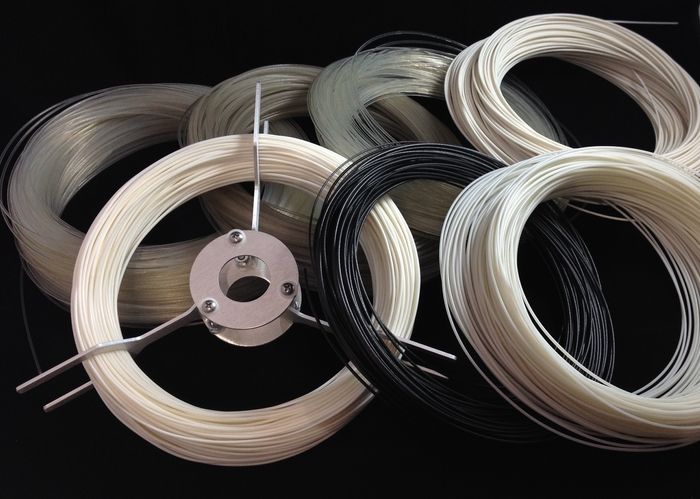 9 ksi 9 ksi | 421 ksi | 6% |
| MicroFine™ (Gray and Green) | Gray or Green | 8.7 ksi | 377 ksi | 8% |
| PP-Like Translucent White (Somos 9120) | Translucent/White | 5.0 ksi | 232 ksi | 25% |
| PC-Like Translucent/Clear (Accura 60) | Translucent/Clear | 10.8 ksi | 508 ksi | 7% |
| PC-Like Advanced High Temp* (Accura 5530) | Translucent/Amber | 6.5 ksi | 566 ksi | 1.5% |
| Ceramic-Like Advanced HighTemp* (PerFORM) | White | 10.9 ksi | 1523 ksi | 1% |
*Properties listed are based on thermal cure
| Material | Color | Tensile Strength | Tensile Modulus | Elongation |
|---|---|---|---|---|
| ABS-Like White (Accura Xtreme White 200) | White | 54.47 Mpa | 3300 Mpa | 9% |
| ABS-Like Gray (Accura Xtreme Gray) | Gray | 39.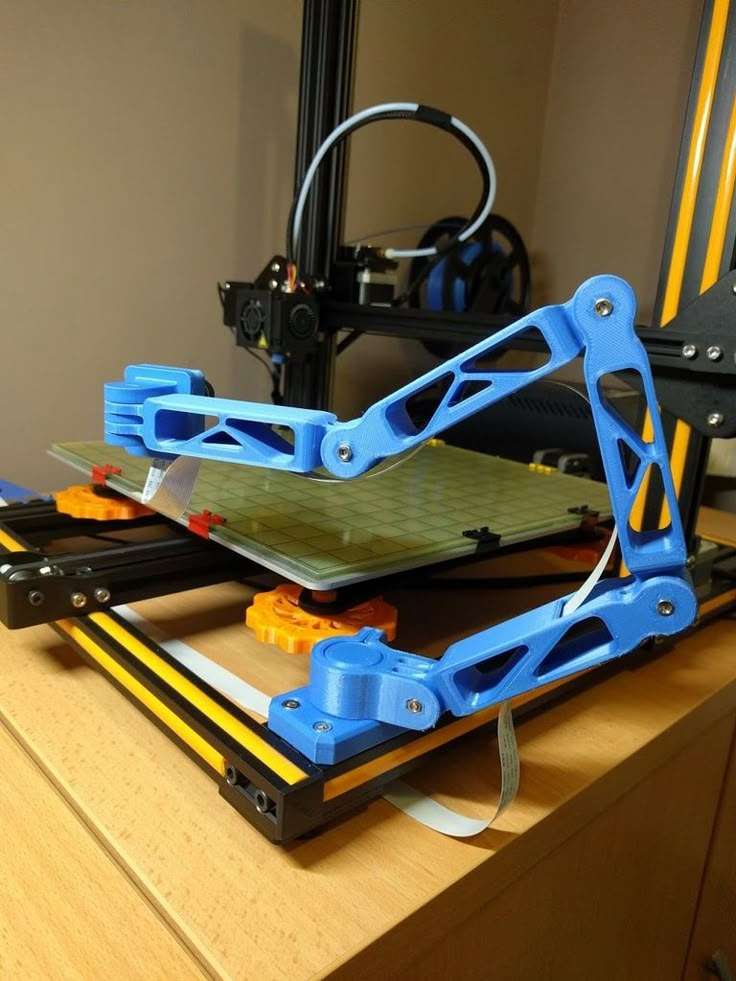 98 Mpa 98 Mpa | 2000 Mpa | 9% |
| ABS-Like Black (RenShape SL7820) | Black | 48.26 Mpa | 3000 Mpa | 5% |
| ABS-Like Translucent/Clear (WaterShed XC 11122) | Translucent/Clear | 54.47 Mpa | 2600 Mpa | 6% |
| MicroFine™ (Gray and Green) | Gray or Green | 59.98 Mpa | 2600 Mpa | 8% |
| PP-Like Translucent White (Somos 9120) | Translucent/White | 34.47 Mpa | 1600 Mpa | 25% |
| PC-Like Translucent/Clear (Accura 60) | Translucent/Clear | 74.46 Mpa | 3503 Mpa | 7% |
| PC-Like Advanced High Temp* (Accura 5530) | Translucent/Amber | 44.81 Mpa | 3902 Mpa | 1.5% |
| Ceramic-Like Advanced HighTemp* (PerFORM) | White | 75.15 Mpa | 10,500 Mpa | 1% |
*Properties listed are based on thermal cure
These figures are approximate and dependent on a number of factors, including but not limited to, machine and process parameters.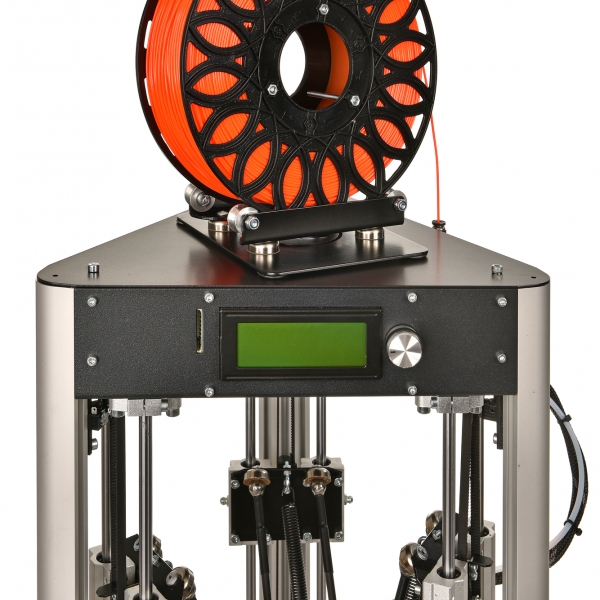 The information provided is therefore not binding and not deemed to be certified. When performance is critical, also consider independent lab testing of additive materials or final parts.
The information provided is therefore not binding and not deemed to be certified. When performance is critical, also consider independent lab testing of additive materials or final parts.
Surface Finish Options for SLA Parts
Material: ABS-like Translucent/Clear
Finish: Unfinished
Material: MicroFine Gray™
Finish: Unfinished
Material: ABS-like Translucent/Clear
Finish: Standard
Material: MicroFine Gray™
Finish: Standard
Material: ABS-like Translucent/Clear
Finish: Natural
Material: MicroFine Gray™
Finish: Natural
Material: ABS-like Translucent/Clear
Finish: Custom
Material: MicroFine Gray™
Finish: Custom
Additional Finishing Options
Custom finishing is a mix of science, technology, and fine art that can transform a part to your exact specifications. Finishes include:
- Soft-touch paint
- Clear part finishing
- Paint finishes
- Masking
- Color matching
- Decals/graphic
- Texture
Metal Plating
Our metal-plating process for SLA coats a ceramic-filled PC-like material (Somos PerFORM) with a nickel that gives parts the look, feel, and strength of metal, but without the weight.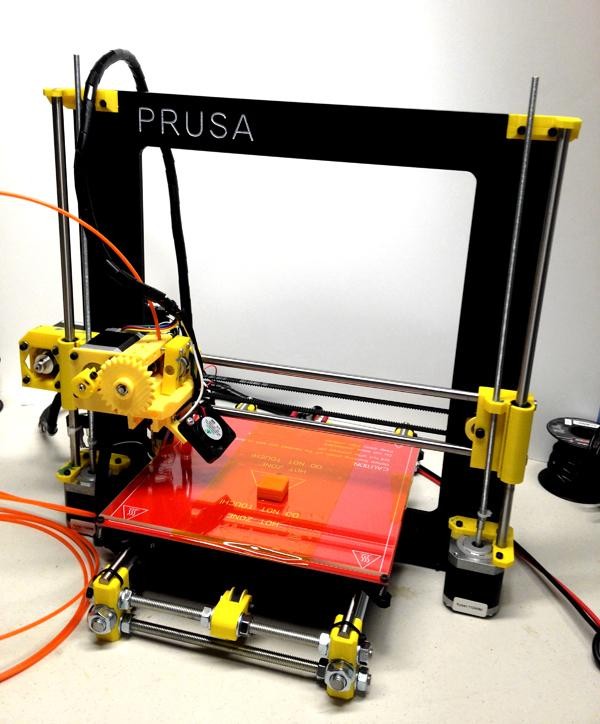 The combination of the material’s strength, rigidity, and temperature resistance with nickel plating, takes strength, stiffness, and impact and temperature resistance to a degree previously unattainable in SLA parts.
The combination of the material’s strength, rigidity, and temperature resistance with nickel plating, takes strength, stiffness, and impact and temperature resistance to a degree previously unattainable in SLA parts.
Microfluidics
Our microfluidic fabrication process is a modified form of high-resolution SLA that uses a clear ABS-like material (WaterShed XC 11122). Parts are resistance to water and humidity, and work well for lens and flow-visualization models.
Our SLA 3D Printers
Our stereolithography machines consists of Vipers, ProJets, and iPros. In high-resolution mode, Vipers and ProJets can make parts with extremely tiny features and crisp details, while in normal-resolution mode, they can build cost-effective parts very quickly.
iPros have extremely large build volumes at 29 in. by 25 in. by 21 in. (736mm by 635mm by 533mm), yet are still able to image highly detailed parts easily.
Why Use SLA?
Stereolithography (SLA) is an additive manufacturing process that can 3D print parts with small features, tight tolerance requirements, and smooth surface finishes.
How Does SLA 3D Printing Work?
The SLA machine begins drawing the layers of the support structures, followed by the part itself, with an ultraviolet laser aimed onto the surface of a liquid thermoset resin. After a layer is imaged on the resin surface, the build platform shifts down and a recoating bar moves across the platform to apply the next layer of resin. The process is repeated layer by layer until the build is complete.
Newly built parts are taken out of machine and into a lab where solvents are used to remove any additional resins. When the parts are completely clean, the support structures are manually removed. From there, parts undergo a UV-curing cycle to fully solidify the outer surface of the part. The final step in the SLA process is the application of any custom or customer-specified finishing. Parts built in SLA should be used with minimal UV and humidity exposure so they don’t degrade.
SLA Resources
Design Tip
An Introduction to Stereolithography (SLA) 3D Printing
Stereolithography, a staple of 3D printing, can deliver complex prototypes quickly and accurately.
Read Design Tip
Design Tip
Selecting a Material for Stereolithography (SLA) 3D Printing
Compare materials for stereolithography with one another and with injection-molded plastics.
Read Design Tip
Blog
SLA vs. FDM: Comparing Common 3D Printing Technologies
See how these two 3D printing technologies stack up for prototype parts. Understanding the advantages of each will help accelerate design.
Read Blog
Guide
What is 3D Printing?
Gain an understanding of additive manufacturing and how it can be leveraged to improve product development through rapid prototyping and production.
Read Guide
Get an instant online quote for 3D printing.
Get a Quote
3D printing in Moscow at the 3D printing laboratory
Application of 3d printing
Gaining popularity and being in great demand, 3D printing on order is becoming an integral and indispensable part of life in our time.
The manufacture of cases and volumetric products is a very profitable solution when small-scale production is spreading.
Layer-by-layer material growth technologies (or fabber technologies) for creating physical objects came to Russia not so long ago, but their popularity is growing rapidly. Performing 3D printing - in Moscow or in any other city - is not a problem today. Products for various purposes - from prostheses to parts for cars and aircraft - can be made on the basis of the fabber method.
The term “additive manufacturing” is accepted in industry guides, however, this technology has become commonly referred to as “3d printing” and it is in this version that it is used in the startup environment, between entrepreneurs and journalists.
Layer-by-layer build-up is applicable both for creating prototypes, prototypes of a future product, and for direct manufacturing of parts and solid objects.
Where is a 3d printer used
In what case may 3D printing be required? At the stage of product development, when it is required to visualize it and determine the likelihood of defects or unsatisfactory quality during production. It is also in demand for creating prototypes of architectural objects, as well as for prototyping.
It is also in demand for creating prototypes of architectural objects, as well as for prototyping.
Prototyping of parts, production of tooling - for example, molds for casting; assembly tools - this is not a complete list of cases when they decide to use 3D printing on order. Moscow in this regard is in a much more advantageous position compared to other Russian regions, since ideas and technologies, for the most part, are concentrated here.
We use additive technologies and high-quality materials to make your models, which will then be presented in many industries after printing: medicine, science and education, architecture and construction, energy and oil and gas industry, automotive and mechanical engineering, aerospace industry, jewelry manufacturing .
3D printing, ordering the release of a single item or a series is possible only on the basis of three-dimensional modeling based on special software products - this is where work on a separate project begins. If you want to create a copy or form of an existing object, you will need to apply three-dimensional scanning.
If you want to create a copy or form of an existing object, you will need to apply three-dimensional scanning.
The principle of operation of a 3d printer
Ordering 3d printing means placing an order for the reproduction of a digital three-dimensional model of an object in physical form by horizontal layering of a substance. Layering is carried out using additive installations or three-dimensional printers, the variety of which is quite large today.
For each of the layering methods, including lamination, fusion, sintering, extrusion, jet spraying, UV curing, there is a separate category of devices. To create an accurate three-dimensional geometric product (3d model) that can perform any function, "3D printer" is used - this is the general name for a whole family of equipment capable of performing 3d printing on order (Moscow). At its core, each device is a numerically controlled machine that performs layering operations.
To reproduce the desired objects, it is necessary to use different 3D printing technologies that differ from each other.
Here are the main 3D printing technologies:
- Fused deposition modeling (FDM). ABS and PLA printing with this technology is the most popular of all 3D printing technologies. It is used in most desktop 3D printers and represents an ideal price / quality ratio, which allows printing by layer-by-layer supply of a filament of molten plastic;
- Laser stereolithography (SLA). Photopolymer printing using SLA technology allows you to form an object by layer-by-layer laser exposure of a liquid photopolymer resin, which hardens under the influence of radiation. One of the variations of this technology is DLP 3D printing. It uses a special projector instead of a laser. Both 3D printing methods are used to create objects with a high degree of detail. In the case of DLP printing, speed is also an added advantage;
- Selective laser sintering (SLS). Reproduction is performed by layer-by-layer melting of a special powder under the action of laser radiation.
 This 3D printing method is widely used in the industry for the manufacture of durable metal elements.
This 3D printing method is widely used in the industry for the manufacture of durable metal elements.
To order printing on a 3d printer using any of the above methods, you must select the material in which the product will be made. What will be the composition of the product, such will be the cost of the work.
Printing on a 3D printer is possible using powder forms of gypsum, polystyrene, polyamides, metal alloys; liquid photopolymers, wax and other materials. The specific task and requirements for the final product depend on which consumables are selected. It is important that with this production method, whatever you choose, there is almost no mechanical post-processing required.
In order to understand the principle of 3D printing, it is necessary to reproduce the step-by-step process of creating models.
Let's describe some stages of 3D printing:
- 3D modeling of the required object according to the specified parameters;
- loading a file with a digital model into a slicer program that generates a control code for a 3D printer;
- setting the required 3D printing parameters;
- writing a code to a removable memory that connects to a 3D printer;
- 3D model reproduction.

Objects are reproduced progressively in the desired shape, the selected material is applied layer by layer, forming the finished product.
The possibilities of 3D printing are almost limitless, that is, you can make anything you want and this is a huge advantage of this type of printing. In some technologies, for very thin overhanging elements, supports are provided, thanks to which, sagging can be avoided.
Such a brief description of the stages, where there is no ready and detailed analysis of the complete picture of the 3D printing process, gives only an idea of the essence of the technique.
What equipment does LAB3DPrint 9 have0003
Due to the fact that 3D printers are quite expensive equipment, and not everyone can use 3D technologies, but there is a need, our company provides printing services quickly, efficiently and in accordance with your wishes, will complete your task.
The high speed and accuracy of printing, as well as the maximum reliability of our 3D printers, reduce the cost of all types of 3D printing.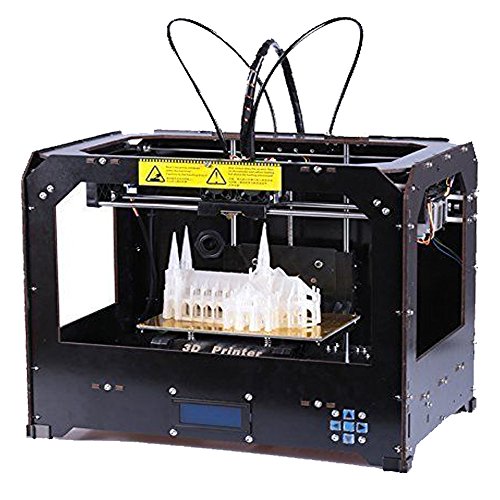
We can order a full range of preparatory work and the actual printing on a 3D printer (Moscow) using various methods and materials. We have all the necessary equipment and software.
Our company works with professional equipment, so the quality of the finished product is guaranteed and the result exceeds all expectations.
In the case of infrequent 3D printing, there is simply no point in purchasing expensive equipment, and the only thing you can do is entrust the creation of any object to us. When you need to print various products, for example, a part made of photopolymer or Abs plastic, you can safely use the services of our company by contacting the site where delivery and payment are processed.
Benefits of Lab3DPrint
Our company provides 3d printing services, creating industrial design items, product prototypes, functional models, layouts, souvenirs and many other objects from sketches and drawings.
Depending on what device and what printing material is used, these will be the cost and turnaround time.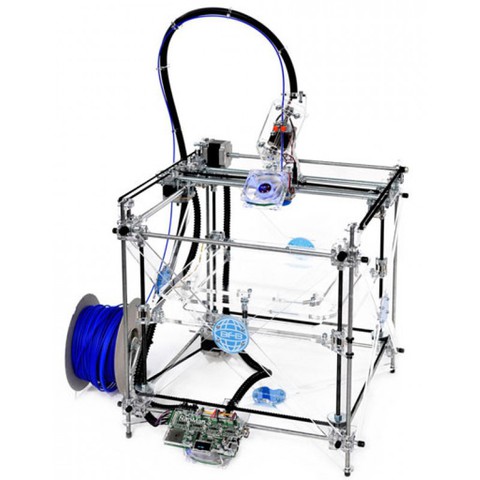
Our staff will help you navigate and make the right choice, as well as take care of the calculations after receiving a file with information about your model.
You only need to describe your task in detail, and we will select the optimal technology and materials for its implementation.
To do this, when placing your order, you must fill out a special form on our website. Here you can also ask questions regarding the production of 3D models.
Write to us and we will be glad to cooperate!
3D Printing and Quality 3D Printing Services - Quote
3D printing is the result of additive manufacturing technology. When creating a three-dimensional object, several layers of a specialized material are successively applied. For this, 3D printers were developed. Compared to other production tools, the printer is the most affordable and easy to manage.
Request 3D Printing
Recently, 3D printing technology has become very popular.
 Some of those who have used a 3D printer think that it can only print the simplest miniature models. In reality, things are completely different. There is a huge range of work that can be done using 3D printers:
Some of those who have used a 3D printer think that it can only print the simplest miniature models. In reality, things are completely different. There is a huge range of work that can be done using 3D printers: - 3D printing plays a very important role in the work of architects and designers. Thanks to this technology, various projects of all degrees of complexity are created (motorways, residential and office buildings, facilities for sports events, warehouse complexes, etc.). 3D allows you to visualize all ideas and visualize them with all even the smallest and smallest details. For a stronger impact on the management, in addition to the project layout, you can add several additional elements (cars, aircraft, construction equipment, ships, human figures, etc.).
- Very well, 3D printing technology helps enterprises to create parts and mechanisms. With the help of 3D printing service, you can recreate an exact copy of any part sample. This copy will have the same properties as the original.
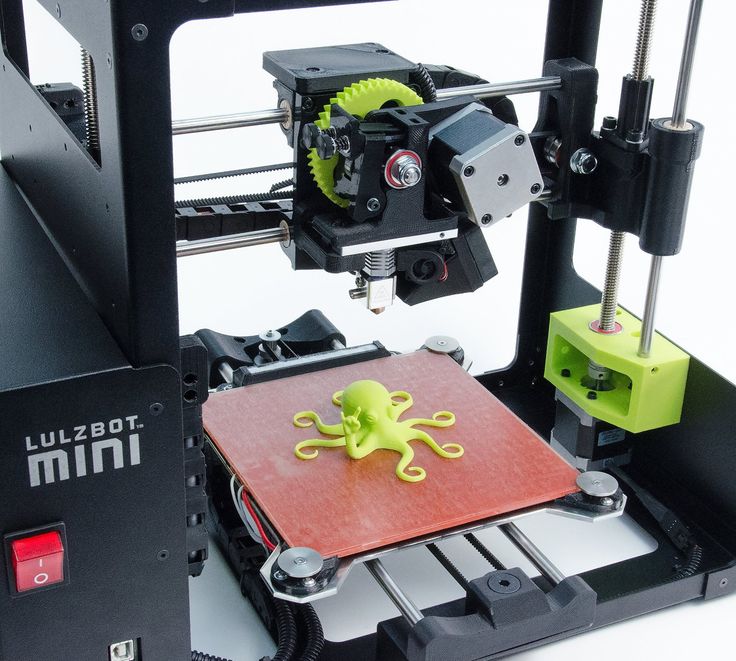 This allows specialists to find existing shortcomings in the mechanism, correct them and evaluate performance.
This allows specialists to find existing shortcomings in the mechanism, correct them and evaluate performance. - Thanks to the use of a 3D printer, it became possible to avoid defects in mass production of parts. To do this, simply order its 3D model and evaluate the quality of the finished product. It is also possible to recreate the housing for electrical appliances. The size and complexity of such cases can be completely different.
- But the 3D printer is used not only in manufacturing to create models of architectural designs and prototype parts, but also to make gifts. The execution of the order will take place as soon as possible and without much difficulty. After some time, you will have a unique souvenir in your hands, which is a miniature model of the selected object.
Advantages of 3D printing technology
The popularity of 3D printing is growing exponentially. And this is not surprising, because it has a number of positive qualities:
Saving a lot of time
Designers and architects now spend significantly less time creating layouts for their projects.
Sleepless nights are a thing of the past
It takes no more than 2 days from the date of order to create miniature models of any complexity.
Versatility
With the help of a 3D printer, orders of any complexity can be processed, even taking into account all the features of the prototype.
Individual approach to each client
In the process of creating a 3D model, all the wishes of the client are taken into account. This allows you to make exact copies that meet all requests.
Reliability
Only high-quality materials with good strength are used to create 3D models. That is why all finished copies are durable.
Vividness
Thanks to the possibility of color printing, each 3D model will be attractive in its own way and will draw the attention of all exhibition visitors and potential customers. Also, color 3D copies can take their place in the interior of the house and decorate it.
Availability
This advantage is considered one of the most important.